Danaus plexippus
The Monarch butterfly (Danaus plexippus) is one of the most recognizable and cherished butterfly species worldwide. Known for their vibrant colors and remarkable migration patterns, they captivate the hearts of many.
Monarchs are native to the Americas, primarily found across the United States, Mexico, and parts of Canada. They are also spotted in Australia, the Canary Islands, and Western Europe, though these populations are not migratory.
The adult Monarch features bright orange wings with a complex pattern of black veins, creating a stunning contrast. The borders of the wings are black with white spots, adding to their distinct appearance. The underparts of the wings are more subdued in color, providing a form of camouflage when the butterfly is at rest.
Males and females can be distinguished by their wing patterns; males have thinner black veins and also feature two highly visible black spots on their hind wings, which are scent glands used during mating.
Their wingspan ranges from 3.5 to 4 inches (9-10 cm), making them a prominent sight in gardens and wildflower fields.
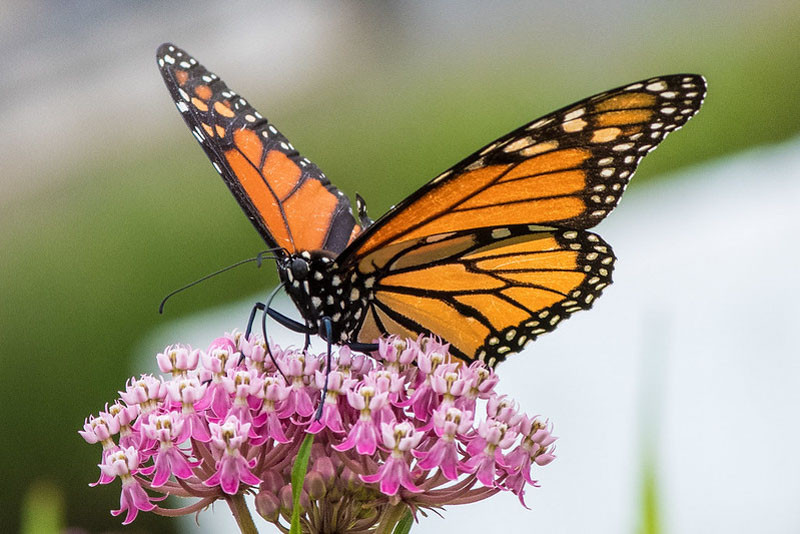 Monarch Butterfly on Milkweed (Asclepias)
Monarch Butterfly on Milkweed (Asclepias)
Monarch butterflies possess a complex and highly developed vision crucial to their navigation and survival. Their compound eyes have numerous tiny lenses, allowing them to perceive a wide range of colors, including ultraviolet light, which is invisible to humans.
They have remarkable color vision, which is essential for locating flowers and distinguishing between different types of vegetation. Monarchs use polarized light from the sun as a compass, helping them to navigate during their long migratory journeys. Their acute vision enables them to detect and respond to predators, ensuring their survival in the wild.
Monarch butterflies exhibit intricate courtship and mating behaviors, primarily occurring during their migration periods. Males actively pursue females, performing aerial dances and releasing pheromones to attract them. Once a female is receptive, the male clasps onto her, initiating mating, which can last several hours.
Post-mating, the female carries the male’s sperm and selectively uses it to fertilize her eggs. She then deposits the eggs on the underside of milkweed leaves, the sole food source for the emerging larvae. This selective mating and egg-laying process ensures the next generation’s survival and continuation of their migratory cycle.
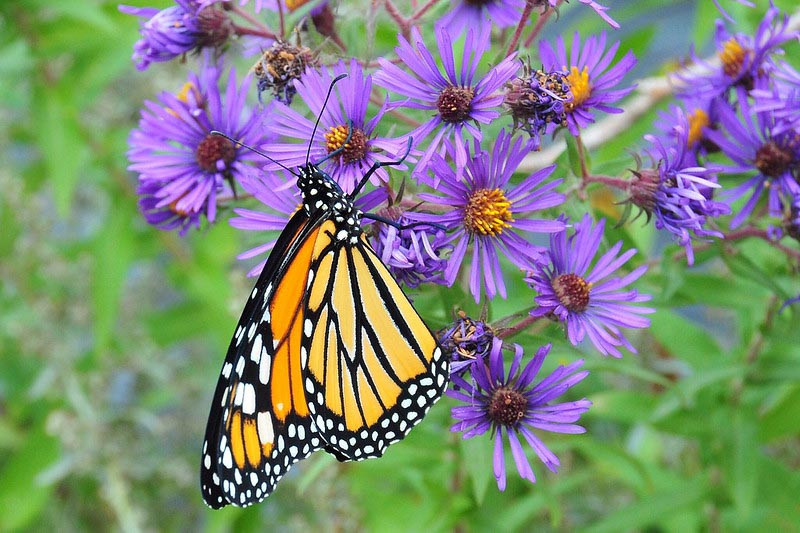
Monarch Butterfly on Aster
The Monarch butterfly undergoes a fascinating and complex life cycle, spanning four distinct stages: egg, larva (caterpillar), pupa (chrysalis), and adult butterfly.
Egg: The life cycle begins when a female Monarch butterfly lays tiny, pinhead-sized eggs on the underside of milkweed leaves. The eggs are creamy white and have a distinct, elongated shape. The female meticulously chooses young, healthy leaves to ensure the survival of her offspring. The eggs hatch in about 3-5 days, depending on temperature.
Larva (Caterpillar): The newly hatched caterpillars are voracious eaters, feeding exclusively on milkweed leaves. They are striped with white, black, and yellow bands and possess a pair of flexible, antennae-like tentacles at each end of their body. Over 9-14 days, the caterpillar undergoes five growth stages, known as instars, molting its skin at each stage. By the final instar, the caterpillar has increased its size manifold.
Pupa (Chrysalis): Once fully grown, the caterpillar attaches itself to a secure surface using a silk pad and transforms into a chrysalis. This pupal stage is a time of drastic transformation. The chrysalis is initially soft and green but hardens and becomes translucent over time, revealing the developing butterfly inside. After about 10-14 days, the adult butterfly is ready to emerge.
Adult Butterfly: The mature Monarch butterfly emerges from the chrysalis with wet and crumpled wings. It pumps hemolymph (insect blood) into the wings to expand them and then rests to allow the wings to harden and dry. The adult butterfly is now ready to feed and mate, and those born in late summer or early fall to undertake the incredible journey of migration.
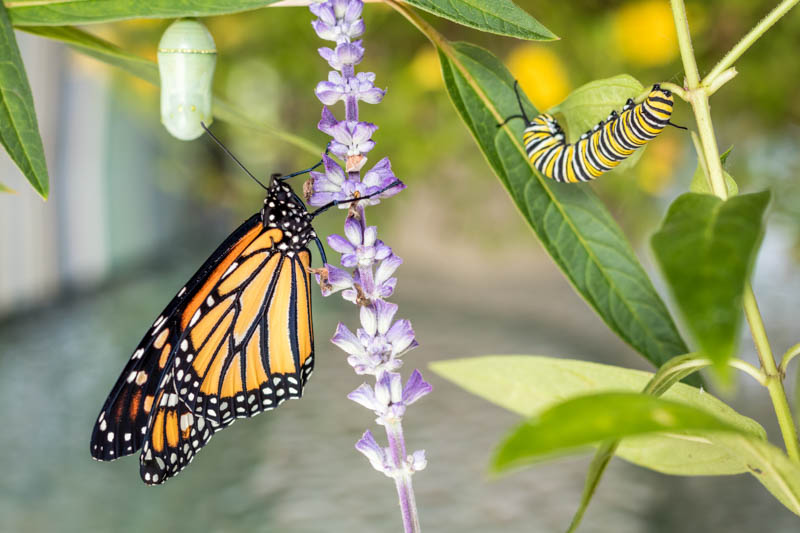 Monarch Trinity: Chrysalis, caterpillar and butterfly on milkweed
Monarch Trinity: Chrysalis, caterpillar and butterfly on milkweed
Monarch butterflies are highly adaptable and can thrive in a variety of habitats, though they have specific requirements for breeding and overwintering. Here’s a detailed look at their habitat preferences:
Breeding Habitats: Monarchs breed in areas where their larval host plants, milkweeds (Asclepias spp.), are abundant. These habitats include:
Overwintering Habitats: In North America, Monarchs that are part of the migratory generation travel thousands of miles to specific overwintering sites.
Migratory Pathways: During migration, Monarchs use a variety of habitats as stopover sites to rest and feed. These include forests and woodlands or agricultural fields, especially those with flowering crops or weeds.
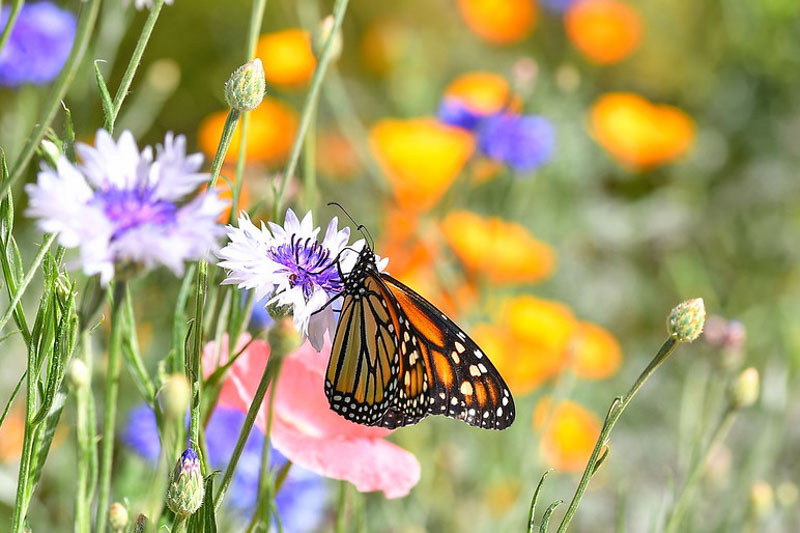
Monarch butterflies have different dietary preferences at various stages of their life cycle. Here’s a breakdown of what they eat:
Larvae (Caterpillars): The caterpillars feed exclusively on milkweed plants (genus Asclepias). Milkweed provides all the nutrients the caterpillars need to grow, and it also makes them toxic to predators. The toxic compounds in milkweed are stored in the caterpillar’s body, providing protection even after they transform into butterflies. Over 100 Milkweed species exist, but the Monarchs prefer species like the Common Milkweed, Swamp Milkweed, and Butterfly Weed.
Adult Butterflies: Adult monarchs primarily feed on nectar from a variety of flowering plants. They prefer flowers that are red, yellow, orange, pink, or purple and have a strong fragrance. Some good options include aster, butterfly bush, cosmos, echinacea, goldenrod, or zinnia.
In some situations, Monarchs might feed on tree sap, rotting fruit, or other organic material to supplement their diet.
Dietary Preferences and Migration: During their long migratory journeys, adult Monarchs need to stop and refuel. They use a variety of nectar-rich flowers along their migratory paths. Creating “monarch waystations” or butterfly gardens with nectar plants and milkweed can provide essential resources for migrating butterflies. Discover our Monarch Guides per State.
Importance of Milkweed: Milkweed is crucial for Monarch survival. Conservationists encourage planting native milkweed species in gardens and public spaces to support Monarch populations. Not only does it provide food for the caterpillars, but female butterflies also lay their eggs on the leaves of milkweed plants.
By providing the necessary food resources and habitat, we can support Monarch butterflies throughout their life cycle and contribute to the conservation of this iconic species.
Monarch butterflies are renowned for their remarkable migratory behavior, displaying a level of endurance and navigation skill that is astonishing for such delicate creatures.
Incredible Journey:
Navigation and Timing:
Energy and Thermoregulation:
Overwintering:
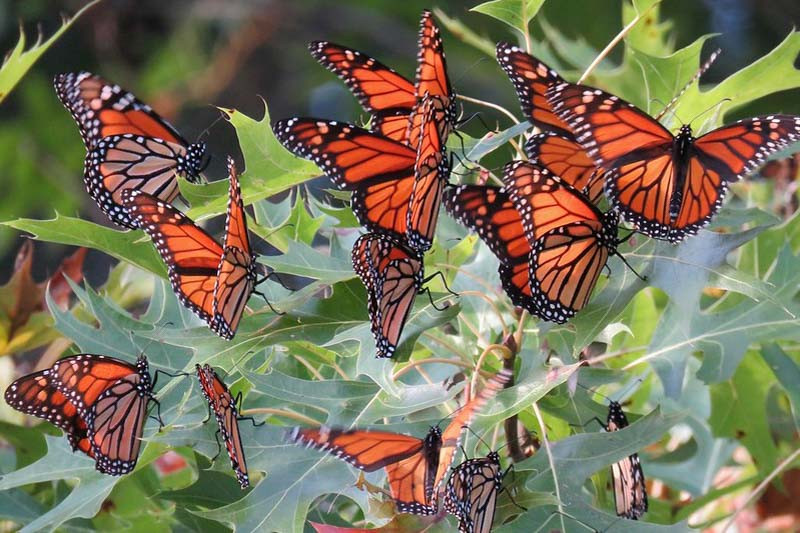
Monarch butterflies, despite their vibrant and beautiful appearance, are not exempt from predation. Various animals target monarchs at different stages of their life cycle. Here’s a look at some of their predators:
Birds: Black-Backed Orioles and Black-Headed Grosbeaks: These are among the few bird species that can eat adult monarch butterflies without being affected by their toxicity.
Some birds may attempt to eat monarchs but are deterred after tasting their toxic and bitter bodies, which is a result of the monarch caterpillar’s diet of milkweed.
Insects: Praying Mantises are known to capture and consume adult monarch butterflies. Ants can attack and eat monarch eggs and larvae. Certain wasp species predate on monarch caterpillars. Spiders: Spiders are known to catch adult monarchs in their webs.
Small Mammals: Mice can feed on the pupae of monarch butterflies, particularly those that overwinter in Mexico.
Parasites and Parasitoids: Tachinid Flies and Braconid Wasps lay their eggs on or in monarch caterpillars. The emerging larvae feed on the caterpillar. Ophryocystis elektroscirrha (OE) is a protozoan parasite that infects monarch butterflies, leading to deformed wings and a weakened state, making them more susceptible to predation.
Human Impact: Human activities like logging and agriculture can indirectly lead to an increase in predation by destroying hiding places and breeding grounds.
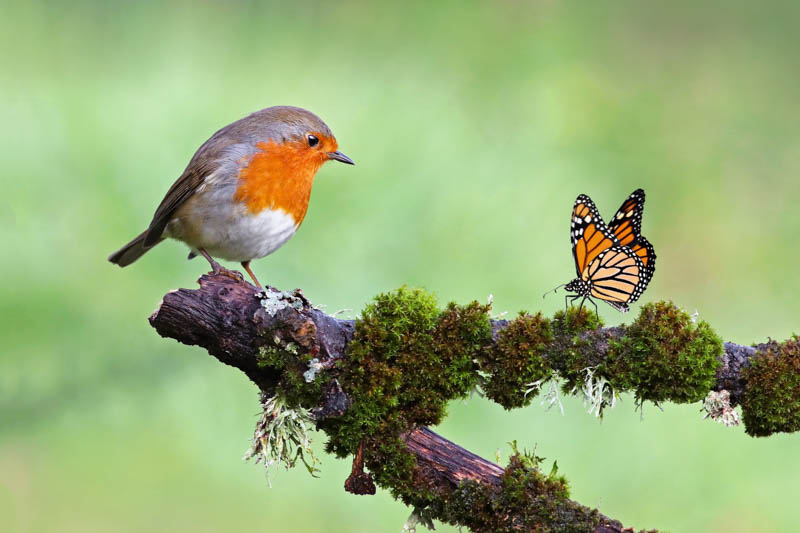
A Wild Robin (Erithacus rubecula) Watching a Monarch Butterfly
Monarch butterflies have evolved certain defense mechanisms to protect themselves. Their bright coloring serves as a warning sign to predators about their toxicity, which is acquired from their diet of milkweed during the larval stage. Some predators have learned to associate this coloring with a bad taste and avoid eating monarchs. Additionally, the monarch’s long migratory journey helps them escape from certain predators, at least temporarily.
Despite these defenses, the loss of habitat, changes in climate, and exposure to pesticides pose significant threats to monarch populations, necessitating conservation efforts to ensure their survival.
Creating a butterfly haven in your garden to attract monarchs requires careful planning and the right selection of plants and features. Monarch butterflies are specifically attracted to certain types of plants for nectar and for laying their eggs. Here’s a comprehensive guide to transform your garden into a monarch sanctuary:
Plant Milkweed: Milkweed is the only type of plant that monarch caterpillars eat. Planting a variety of milkweeds native to your region will provide food for the larvae. Including different species of milkweed ensures a longer blooming season, providing resources throughout the monarchs’ breeding season.
Nectar-Rich Flowers: Plant a variety of nectar-rich flowers to attract adult monarchs. Include plants that bloom at different times to ensure a consistent food supply. Monarchs are attracted to brightly colored and fragrant flowers. Opt for reds, oranges, yellows, and pinks.
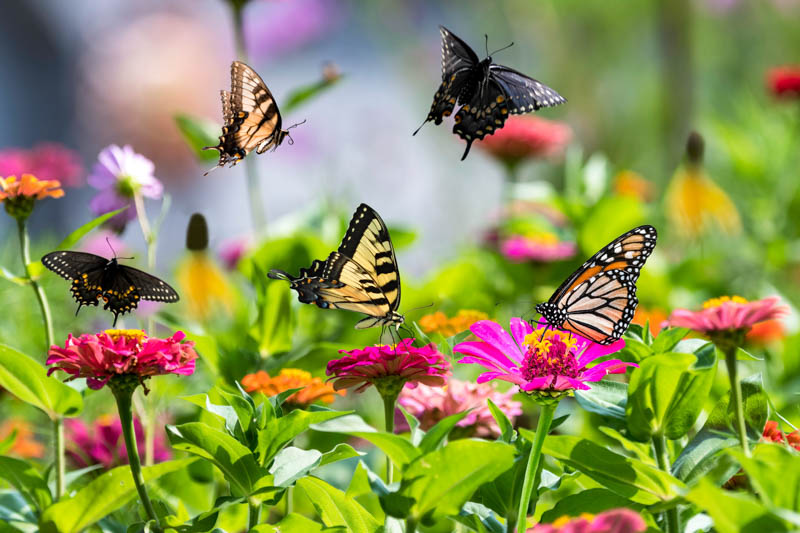
Create a Safe Environment: Provide shelter from harsh weather and predators. Planting dense shrubs or creating a hedgerow can offer protection. A shallow water source, like a birdbath with pebbles or sand for landing spots, ensures butterflies stay hydrated.
Avoid Pesticides: Avoid using pesticides in your garden. They can harm or kill butterflies and caterpillars.
Provide Sun and Shade: Butterflies need to warm up their bodies in the sun to fly. Providing sunny spots with flat stones for basking is essential. Ensure there are also shaded areas for the butterflies to cool down during hot weather.
Maintain the Habitat: Ensure that the plants are healthy and that the habitat is free from invasive species. Pay attention to which plants are most popular with the butterflies, and consider adding more to your garden.
By transforming your garden into a butterfly haven, you’re contributing to the conservation of monarch butterflies and enhancing the biodiversity of your local ecosystem. The vibrant fluttering of butterflies will not only benefit the environment but also provide beauty and interest in your garden, creating a serene and lively outdoor space.
Create a membership account to save your garden designs and to view them on any device.
Becoming a contributing member of Gardenia is easy and can be done in just a few minutes. If you provide us with your name, email address and the payment of a modest $25 annual membership fee, you will become a full member, enabling you to design and save up to 25 of your garden design ideas.
Join now and start creating your dream garden!
Create a membership account to save your garden designs and to view them on any device.
Becoming a contributing member of Gardenia is easy and can be done in just a few minutes. If you provide us with your name, email address and the payment of a modest $25 annual membership fee, you will become a full member, enabling you to design and save up to 25 of your garden design ideas.
Join now and start creating your dream garden!